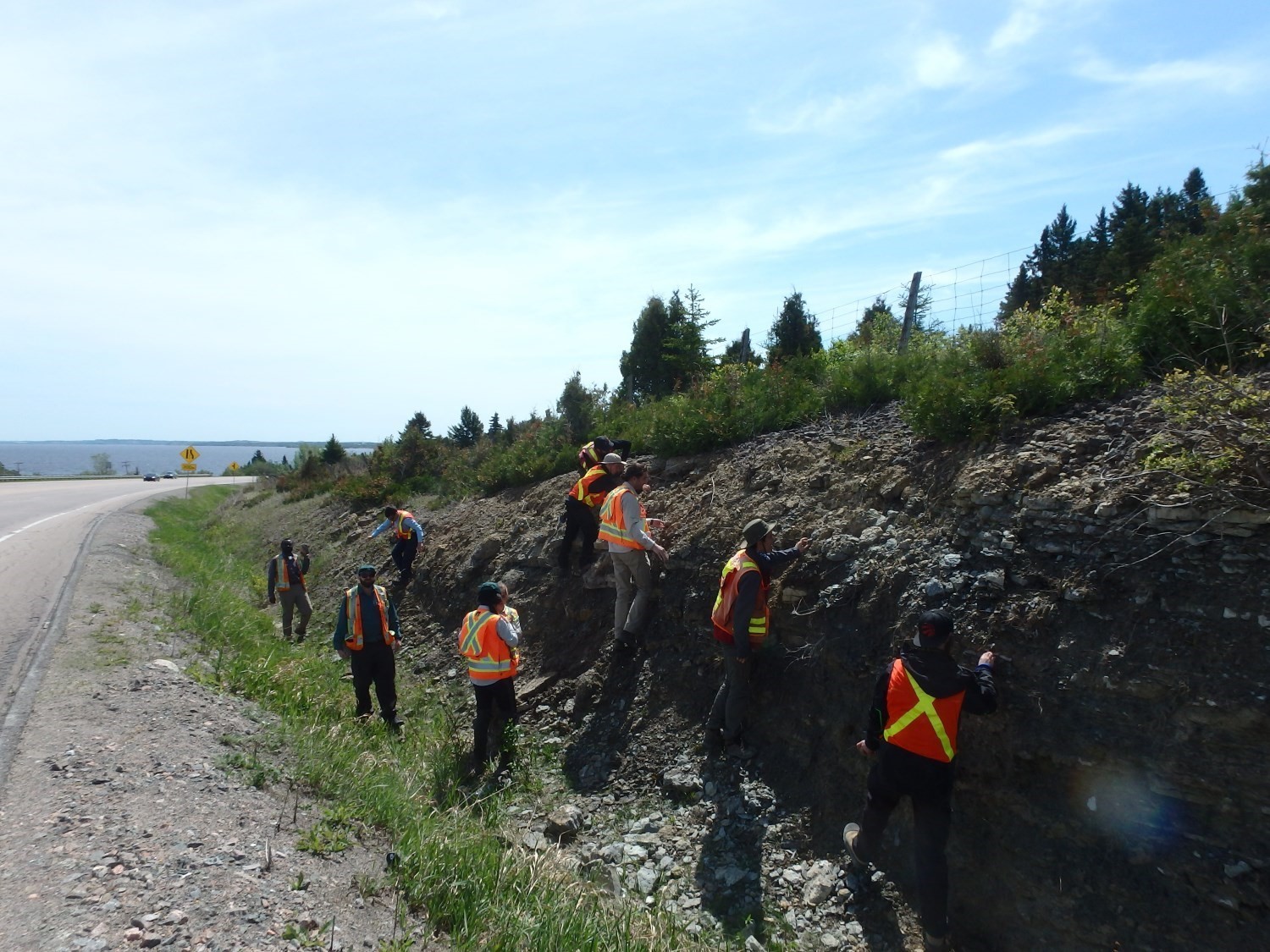
None
| Author: | Sinclair, 1953 |
| Age: | Upper Ordovician |
| Reference section: | Shipshaw River, at Chute-aux-Galets (type locality) |
| Type area: | Saguenay area (NE corner of NTS sheet 22D06) |
| Geological province: | St. Lawrence Platform |
| Geological subdivision: | St. Lawrence Lowlands Platform |
| Lithology: | Echinoderm calcarenite |
| Type: | Lithostratigraphic |
| Rank: | Formation |
| Status: | Formal |
| Use: | Active |
- Trenton Group
- Tétreauville Formation
- Montréal Formation
- Neuville Formation
- Deschambault Formation
- Hull Formation
- Saint-Marc Formation
- Mile End Formation
- Ouareau Formation
- Fontaine Formation
- Pont-Rouge Formation
- Sainte-Anne Formation
- Galets Formation
- Shipshaw Formation
- Simard Formation
- Tremblay Formation
- René-Levasseur Formation
Background
The Upper Ordovician (449-454 Ma) Galets Formation was introduced by Sinclair (1953) in the Lake Saint-Jean area. This formation belongs to the St. Lawrence Platform, which forms a slice in the Grenville Province. All Ordovician sedimentary rocks in this region were assigned to the Trenton Group by several authors from a chronostratigraphic perspective (e.g., Dresser and Denis, 1946; Sinclair, 1953). Other authors have done so on lithostratigraphic bases (Benoit and Valiquette, 1971; Harland et al., 1985, 1987). Instead, Desbiens and Lespérence (1989) proposed the creation of a new group for these rocks, but did not. Although spatial correlation between these Ordovician rocks in the Lake Saint-Jean area and those of the Trenton Group of the St. Lawrence Platform is not formally established, the Galets Formation is maintained in this group.
Description
The Galets Formation consists of a single echinoderm calcarenite (grainstone) facies. This calcareous facies is bedded (<1 m, 50 cm on average), well sorted and bioclastic. It was deposited in a high-energy and shallow sedimentation environment (turbulent regime), locally affected by tidal currents (subtidal zone; Jones and Desrochers, 1992). Shale beds are scarce. Calcarenite is massive and contains calcisiltite (packstone) beds approximately 5-10 cm thick and that can make up 30% of the sequence. Sedimentary figures such as cross-lamination, cross-bedding and hummocky cross-stratification are observed in the Galets Formation. The latter is also characterized by high P2O5 content (0.07-18.91%; Jones and Desroches, 1992).
In the Lake Saint-Jean area, the Galets Formation and the three other related formations (Shipshaw, Simard and Tremblay) cannot be mapped at the 1:50 000 scale because they are generally not more than 50 m thick and subhorizontal (<4° dip). On the geological map of the Saguenay–Lac-Saint-Jean region (sheets 32A08 and 22D), the Trenton Group is hence shown instead of these four related formations.
Thickness and Distribution
The maximum thickness of the Galets Formation is 10 m, measured at Chute-aux-Galets (Lavoie and Asselin, 1998).
Dating
None.
Stratigraphic Relationship(s)
The Galets Formation overlays the Shipshaw Formation and is in contact with shales of the Pointe-Bleue Formation that broadly cover it. This contact is observed at several locations, for example along the shore of Lake Saint-Jean near the village of Mashteuiatsh (Pointe-Bleue).
The stratigraphic column shows the pile of the other three formations in relation to the Galets Formation in the section studied by Lavoie and Asselin (1998) in the Chambord area (NE corner of NTS sheet 32A08).
Paleontology
Fossils found in the Galets Formation are mostly fragmented crinoids, bryozoans, brachiopods, molluscs and trilobites (Cyclospira bisulcata, Isotelus gigas, Isotelus sp., Illaenus americanus, Ceraurus matranseris, Flexicalymene senaria; Table 1, Desbiens and Lespérence, 1989). The fauna contained in the Galets Formation indicates an Edenian (Upper Ordovician) age.
References
| Author(s) | Title | Year of Publication | Hyperlink (EXAMINE or Other) |
|---|---|---|---|
| SINCLAIR, G.W. | Middle Ordovician beds in the Saguenay Valley, Québec. American Journal of Sciences, volume 251, pages 841-854. | 1953 | Source |
| DRESSER, J.A. – DENIS, T. | La géologie de Québec. Ministère des Mines du Québec, volume II, région du Lac Saint-Jean, page 227-251. | 1946 | RG020-II |
| DESBIENS, S. – LESPÉRENCE, P.J. | Stratigraphy of the Ordovician of the Lac Saint-Jean and Chicoutimi outliers, Quebec. Canadian Journal of Earth Sciences, volume 26, pages 1185-1202. | 1989 | Source |
| MCGERRIGLEH., W. | Faunas of the limestone and shale formations of the Simard area. In Annual Report for 1932, part D. Quebec Department of Mines, page 73-81. | 1933 | – |
| BENOIT, F.W. – VALIQUETTE, G. | Région du Lac Saint-Jean (partie sud). Ministère des Richesses naturelles, Québec. RG 140, 29 pages et 5 plans. | 1971 | RG140 |
| HARLAND, T.L. – PICKERILL, R.K. – FILLION, D. | Ordovicia intracratonic sediments from the Lac Saint-Jean and Chicoutimi areas, Quebec, eastern Canada. Canadian Journal of Earth Sciences, volume 22, pages 240-255. |
1985 | Source |
| HARLAND, T.L. – PICKERILL, R.K. – FILLION, D. | Establishment and development of patch reefs in the intracratonic Ordovician sequence near Chicoutimi, Quebec. Lethaia, volume 20, pages 189-208. | 1987 | Source |
| JONES, B. – DESROCHERS, A. | Shallow Platform Carbonates. In: Facies Models: Response to Sea Level Changes, Ed. by R.G. Walker and N.P. James, Geological Association of Canada, pages 277-301. | 1992 | – |
| LAVOIE, D. – ASSELIN, E. | Upper Ordovician facies in the Lac Saint-Jean outlier, Québec (eastern Canada): palaeoenvironmental significance for Late Ordovician oceanography, Sedimentology, volume 45, pages 817-832 | 1998 | Source |


